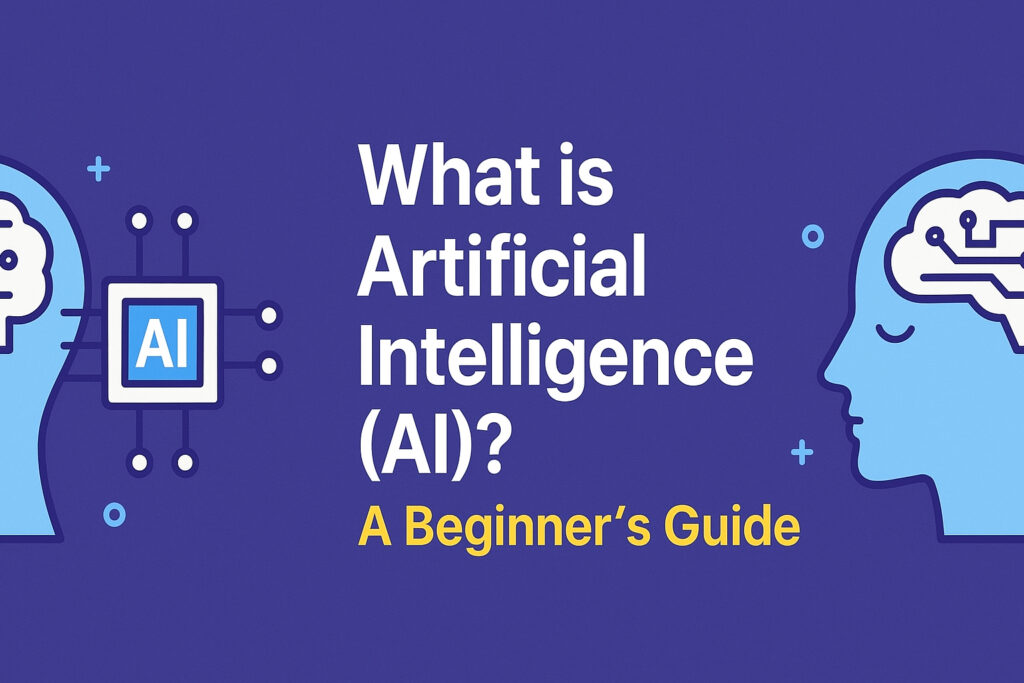
What is Artificial Intelligence (AI)? A Beginner’s Guide to the Future
Artificial Intelligence (AI) has become one of the most talked-about topics in the modern tech world. It’s not just a buzzword—it’s a revolution that is reshaping industries, businesses, education, and even our everyday lifestyle. But for beginners, AI can often feel confusing. What exactly is AI? How does it work? What types of AI exist? And most importantly, how is it shaping our future in 2025?
This Beginner’s Guide to AI will give you a clear and simple understanding of Artificial Intelligence, how it functions, its different categories, and its real-world applications.
* What is Artificial Intelligence (AI)?
Artificial Intelligence (AI) is the simulation of human intelligence in machines. In simple words, AI allows machines to think, learn, reason, and solve problems just like humans. Instead of being programmed with strict rules, AI systems are designed to learn from data, adapt to new situations, and improve their performance over time.
Some common examples of AI you already interact with:
- Google Translate helping you translate languages instantly
- Siri, Alexa, or Google Assistant answering your voice commands
- Netflix or YouTube recommendations based on your interests
- ChatGPT and other AI chatbots generating content and ideas
So, Artificial Intelligence is not a futuristic concept anymore—it’s already part of our daily lives.
* Beginner’s Guide to AI
For those who are just getting started with AI, it’s important to understand the basics:
- Data is the fuel of AI – The more quality data AI has, the smarter it becomes.
- Algorithms are the brain – AI uses mathematical models and algorithms to process data and make predictions.
- Machine Learning (ML) – A core part of AI where machines “learn” from past data and improve accuracy without being reprogrammed.
- Deep Learning & Neural Networks – Advanced AI systems that mimic the human brain to recognize speech, images, and patterns.
- Real-World Use Cases – From smart home devices to self-driving cars, AI is everywhere.
If you’re new to AI, start small—explore free AI tools, read guides, and experiment with AI-powered apps.
* How AI Works: A Simple Explanation
AI works by combining data, algorithms, and computing power. Here’s the basic process:
- Input – The AI system receives raw data (text, images, numbers, or speech).
- Processing – Algorithms analyze this data and look for patterns.
- Learning – Using Machine Learning, AI adjusts itself based on the feedback and outcomes.
- Output – The AI provides predictions, recommendations, or decisions.
. Example: When you type a query into Google Search, AI scans billions of web pages in seconds and shows you the most relevant results.
* Types of AI: Narrow, General & Super AI
AI can be divided into three main categories:
- Narrow AI (Weak AI)
- Designed for a specific task
- Examples: Siri, Google Maps, Chatbots
- Most AI systems today are Narrow AI
- General AI (Strong AI)
- AI that can think, learn, and perform any intellectual task like a human
- Still under research, not yet achieved
- Super AI
- AI that surpasses human intelligence and creativity
- Exists only in theory and sci-fi movies for now
* AI Applications in 2025
AI is growing rapidly, and by 2025, its applications will expand into nearly every industry:
- Education – Personalized learning experiences, AI tutors, smart grading systems
- Healthcare – Early disease detection, AI-powered diagnosis, robotic surgeries
- Finance – Fraud detection, automated trading, AI-based financial advice
- Business & Marketing – Customer support chatbots, content creation, targeted ads
- Smart Homes – AI-driven devices like smart speakers, security systems, and appliances
- Creative Industry – AI-generated art, video editing, music composition, and storytelling
By 2025, AI will no longer be an option—it will be a necessity for businesses and individuals.
* Conclusion
Artificial Intelligence (AI) is not just about robots or science fiction—it’s a real and powerful technology that’s transforming our world. This Beginner’s Guide to AI has shown how AI works, its different types, and how it’s being applied in 2025. Whether you’re a student, entrepreneur, or just curious, learning about AI will help you prepare for a future where human and machine intelligence work together.
* FAQs: Common WH Questions About AI
1. What is Artificial Intelligence (AI) in simple words?
AI is when machines are programmed to think, learn, and solve problems like humans.
2. How does AI work in real life?
AI collects data, analyzes it with algorithms, and produces smart decisions or predictions.
3. What are the main types of AI?
The three categories are Narrow AI, General AI, and Super AI.
4. Why is AI important in 2025?
AI will help in healthcare, finance, education, business, and daily life, making tasks easier and smarter.
5. How can beginners learn AI?
Start with online courses, free AI tools, and beginner-friendly resources to practice.
6. Will AI replace human jobs?
AI will replace some repetitive jobs but will also create new career opportunities in tech, AI, and automation.
7. What are examples of AI we use daily?
Voice assistants (Siri, Alexa), recommendation systems (Netflix, YouTube), chatbots, and smart home devices.